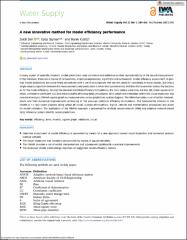| dc.contributor.author | Şen, Zekai | |
| dc.contributor.author | Şişman, Eyüp | |
| dc.contributor.author | Kızılöz, Burak | |
| dc.date.accessioned | 2022-12-14T11:35:11Z | |
| dc.date.available | 2022-12-14T11:35:11Z | |
| dc.date.issued | 2022 | en_US |
| dc.identifier.citation | Şen, Z., Şişman, E. ve Kızılöz, B. (2022). A new innovative method for model efficiency performance. Water Supply, 22(1), 589-601. https://doi.org/10.2166/ws.2021.245 | en_US |
| dc.identifier.issn | 1606-9749 | |
| dc.identifier.issn | 1607-0798 | |
| dc.identifier.uri | https://doi.org/10.2166/ws.2021.245 | |
| dc.identifier.uri | https://hdl.handle.net/20.500.12511/10119 | |
| dc.description.abstract | In every aspect of scientific research, model predictions need calibration and validation as their representativity of the record measurement. In the literature, there are a myriad of formulations, empirical expressions, algorithms and software for model efficiency assessment. In general, model predictions are curve fitting procedures with a set of assumptions that are not cared for sensitively in many studies, but only a single value comparison between the measurements and predictions is taken into consideration, and then the researcher makes the decision as for the model efficiency. Among the classical statistical efficiency formulations, the most widely used ones are bias (BI), mean square error (MSE), correlation coefficient (CC) and Nash-Sutcliffe efficiency (NSE) procedures all of which are embedded within the visual inspection and numerical analysis (VINAM) square graph as measurements versus predictions scatter diagram. The VINAM provides a set of verbal interpretations and then numerical improvements embracing all the previous statistical efficiency formulations. The fundamental criterion in the VINAM is 1:1 (45 degrees) main diagonal along which all visual, science philosophical, logical, rational and mathematical procedures boil down for model validation. The application of the VINAM approach is presented for artificial neural network (ANN) and adaptive network-based fuzzy inference system (ANFIS) model predictions. | en_US |
| dc.language.iso | eng | en_US |
| dc.publisher | IWA Publishing | en_US |
| dc.rights | info:eu-repo/semantics/openAccess | en_US |
| dc.rights | Attribution 4.0 International | * |
| dc.rights.uri | https://creativecommons.org/licenses/by/4.0/ | * |
| dc.subject | Efficiency | en_US |
| dc.subject | Error | en_US |
| dc.subject | Models | en_US |
| dc.subject | Square Graph | en_US |
| dc.subject | Validation | en_US |
| dc.subject | Visual | en_US |
| dc.title | A new innovative method for model efficiency performance | en_US |
| dc.type | article | en_US |
| dc.relation.ispartof | Water Supply | en_US |
| dc.department | İstanbul Medipol Üniversitesi, Mühendislik ve Doğa Bilimleri Fakültesi, İnşaat Mühendisliği Bölümü | en_US |
| dc.department | İstanbul Medipol Üniversitesi, Rektörlük, İklim Değişikliği Araştırmaları Araştırma Merkezi (İKLİMER) | en_US |
| dc.authorid | 0000-0003-2754-5492 | en_US |
| dc.authorid | 0000-0003-3696-9967 | en_US |
| dc.identifier.volume | 22 | en_US |
| dc.identifier.issue | 1 | en_US |
| dc.identifier.startpage | 589 | en_US |
| dc.identifier.endpage | 601 | en_US |
| dc.relation.publicationcategory | Makale - Uluslararası Hakemli Dergi - Kurum Öğretim Elemanı | en_US |
| dc.identifier.doi | 10.2166/ws.2021.245 | en_US |
| dc.institutionauthor | Şen, Zekâi | |
| dc.institutionauthor | Şişman, Eyüp | |
| dc.identifier.wosquality | Q4 | en_US |
| dc.identifier.wos | 000683382400001 | en_US |
| dc.identifier.scopus | 2-s2.0-85123641917 | en_US |
| dc.identifier.scopusquality | Q3 | en_US |



















